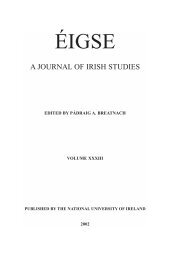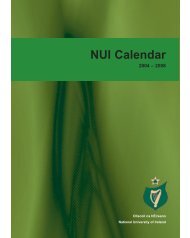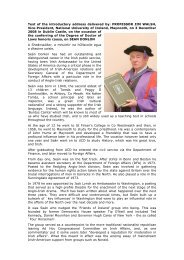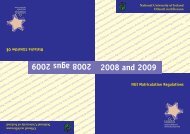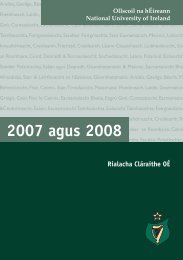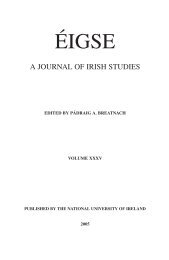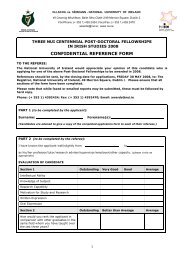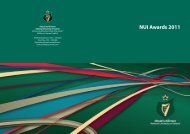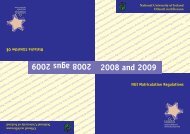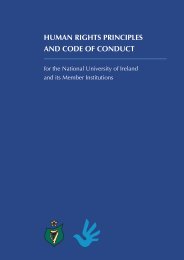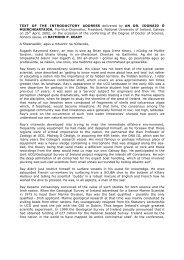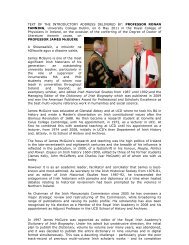Eigse Paged 2004 - National University of Ireland
Eigse Paged 2004 - National University of Ireland
Eigse Paged 2004 - National University of Ireland
Create successful ePaper yourself
Turn your PDF publications into a flip-book with our unique Google optimized e-Paper software.
AILBE’S SPEECH TO CITHRUAD (TOCHMARC AILBE)<br />
INTRODUCTION<br />
Tochmarc Ailbe was edited and translated from its only witness, the<br />
miscellaneous vellum manuscript H. 3.17 (Trinity College Dublin),<br />
pp. 827-831, by Rudolf Thurneysen in his article ‘Tochmarc Ailbe<br />
“Das Werben um Ailbe”’ (1920-21). The story starts after Gráinne,<br />
eldest daughter <strong>of</strong> Cormac mac Airt, has been divorced from Finn<br />
mac Cumaill (Corthals 1997) and peace has been restored between<br />
the two men. It narrates how Ailbe Grúadbrec, Cormac’s youngest<br />
daughter, wishing to marry, was courted by Finn and, despite the<br />
warnings <strong>of</strong> her father, agreed to join with him and to lead an adventurous<br />
life among the fíana. Thurneysen’s translation did not include<br />
Ailbe’s address to the druid Cithruad, spoken in difficult rhetorical<br />
speech, concerning her marital future. For this text he gave a transcription<br />
only (1920-21: 254-6, §3).<br />
The text <strong>of</strong> this speech given below is based on a new collation<br />
with H. 3.17, p 827, ll. 13-23. Its orthography, which agrees with that<br />
<strong>of</strong> its prose and verse context, combines features <strong>of</strong> Middle Irish<br />
orthography with reflexes <strong>of</strong> later spoken language. Thus /γ/ is<br />
mostly written d (e.g. l. 7 sluadtodo for sluagthogu) which indicates<br />
Middle Irish merger <strong>of</strong> /γ/ and /ð/ (Breatnach 1994: 234-5, and<br />
McManus 1994: 351-2). If I am right in reading l. 21 cuibi as a modern<br />
equivalent <strong>of</strong> Old Irish cuibde (Mod. Ir. cuí), this would reflect<br />
loss <strong>of</strong> the resulting approximant (McManus 1994: 351) after /ß/. In<br />
two cases th, which had become voiceless /h/ by the beginning <strong>of</strong> the<br />
Early Modern Irish Period (McManus 1994: 351), is not written in<br />
postconsonantal position (l. 19 cairpi for cairpthi, l. 27 coslebair<br />
[b = /f/] for coslebthair).<br />
There is no strict metrical structure. The text is based on units <strong>of</strong><br />
different length ending mostly, but not always, in a trisyllabic<br />
cadence that alliterates with the preceding word, but not with the<br />
first word <strong>of</strong> the following line. It ends in an imperfect dúnad (Friscomart<br />
… fri fius). For such a structure compare, among other examples,<br />
a druid’s prophecy cited by Bé Guba (Brónaid banntrochta<br />
díthbath fer fri ferbaib Athairni … bithbrónán ‘Womenfolk grieve at<br />
the destruction <strong>of</strong> men by the words <strong>of</strong> Athairne … lasting sorrow’)<br />
in Tochmarc Luaine (Breatnach 1980: 13-14). An early example is to<br />
be found in the rhetorical passages <strong>of</strong> Echtrae Chonnlai (McCone<br />
2000: 121-2). Some further features are indicative <strong>of</strong> retoiric- or



